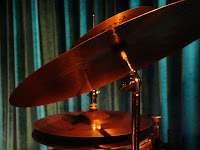
A friend suggested that I devote one of my posts to definitions of various jazz styles. Actually, no definition in words could fully give a true impression of what each style sounds like, plus sometimes the styles may dovetail to create a kind of jazz hybrid. Also, there are many jazz performers who made important recordings in several styles. At any rate, I'll attempt to give brief descriptions of many of the different types and at the end of each section, I'll have links so you can hear (and in most cases see) performances which illustrate them.
New Orleans or Dixieland originated, logically, in African-American communities of New Orleans and combined elements of African and European music. King Oliver, Sidney Bechet and Jelly Roll Morton are among those who performed in this style, but probably the best known performer was Louis Armstrong. For a film of the trumpeter in his prime click here.
Swing, which is generally performed by big bands, had its heyday from the 1930s through the 1940s. It incorporates a brass section made up of trumpets and trombones, a reed section made up of saxophones and clarinets, and a rhythm section made up of piano, bass and drums. Sometimes there is also a guitar or violin. Vocalists are also often utilized. This type of jazz is known for its swinging or flowing rhythm, as well as brisk tempos. However, slower tempos may also be used, in the case of ballads. Generally, swing has been popular with dancers and led to the creation of the lindy and fox trot, among other dance styles. Some of the bands which were popular have included Duke Ellington, Count Basie, Glenn Miller, Woody Herman and Benny Goodman. Since it is currently Benny Goodman's Centennial, it seems appropriate to include a performance by his orchestra. To watch it, click here.
Bebop tends to be more soloist-driven than swing, and stresses virtuosity in playing and harmonic improvisation. Among the best-known proponents of this style are Charlie Parker, Dizzy Gillespie and Thelonious Monk. A video example featuring Parker and Gillespie can be seen by clicking here.
Hard Bop is a harder-edged extension of bebop, incorporating r&b, gospel and the blues (although the latter could to a certain extent be sometimes found in Bebop as well). Miles Davis, John Coltrane and Art Blakey are among those who made major recordings utilizing this style. For a video of Art Blakey's Jazz Messengers click here.
Often the term "Funk Jazz" is used similarly to the term "Hard Bop," but the one musician who generally comes to mind as one of its innovators is Horace Silver. A fine example of his playing can be seen here.
Cool is generally perceived as more relaxed and less aggressive than Bebop, and superficially seems like a more-refined style of jazz. Stan Getz, Lee Konitz, Warne Marsh and Miles Davis, often with Gil Evans, are often identified with this style. To see a video of Miles with Gil, click here.
West Coast, which refers to the jazz played in California, actually includes many types of jazz, but is usually thought of as part of the Cool Jazz movement. Gerry Mulligan, Chet Baker, Dave Brubeck, Shorty Rogers and Bud Shank are among the major musicians associated with this music. For a video of Shorty Rogers click here.
Free is an attempt to go beyond the conventions of jazz in melodies, tempos and chords. As this style was developed it tended to go further and further into abandonment of set structures. Ornette Coleman, Don Cherry, Cecil Taylor, Sun Ra and late-career John Coltrane are among the ones who pushed the music to the limits. You can see Cecil Taylor playing solo piano by clicking here.
Third Stream, an amalgam of classical music and jazz, is often associated with the composer Gunther Schuller. To hear an example of a piece by the reed player Jimmy Giuffre as performed by Gunther Schuller's Orchestra, go here.
Fusion is yet another merger of jazz improvisation with other musical forms, in this case rock, funk and r&b. It generally incorporates the use of electric guitars, basses and keyboards. Miles Davis, Chick Corea, Weather Report, John McLaughlin and Herbie Hancock have been major performers of this style. Click on here to watch a prime example of "electric" Herbie.
A detailed discussion of the various genres and sub-genres of jazz could go on for many posts, but I hope that this very brief overview will give you a good idea of the many developments which have taken place throughout its history.
(Photo courtesy of The Jazz Paisan)
No comments:
Post a Comment